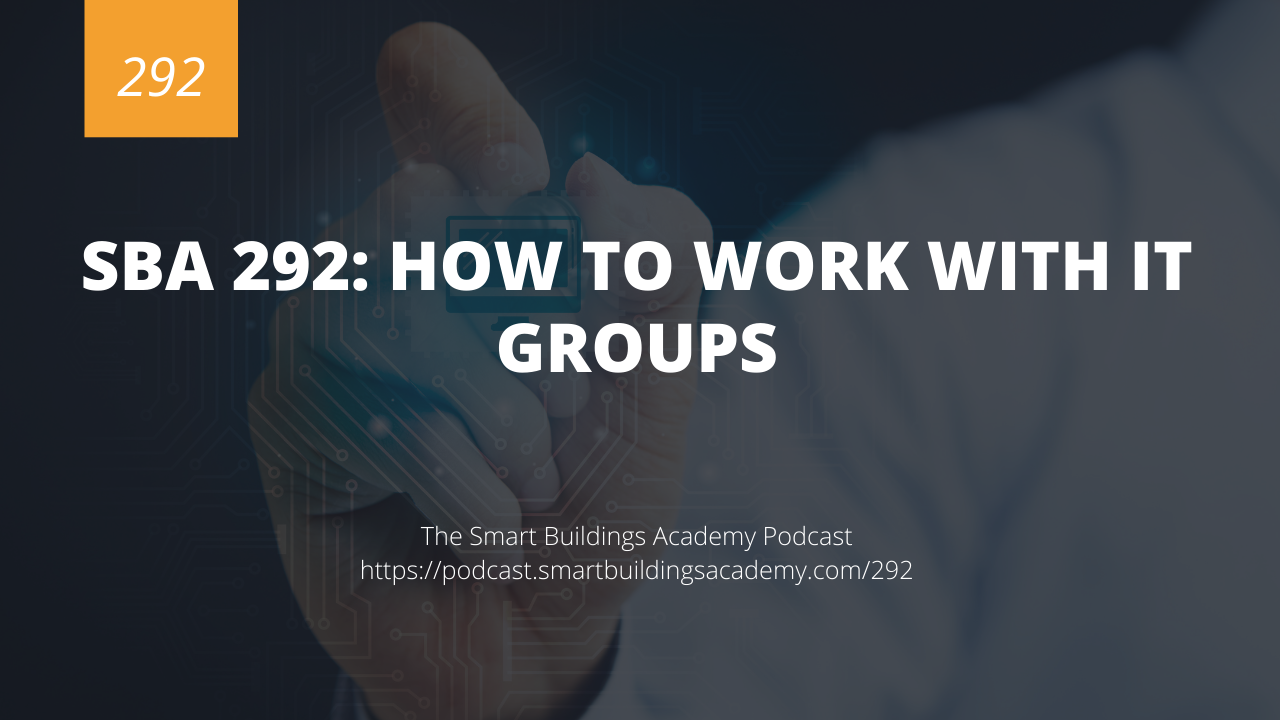In this episode we discuss how to work with IT groups and IT personnel on your building automation projects.
You will learn what roles exist within IT groups, when to engage IT groups, and how to work with IT groups to get your project needs met.
Click here to download or listen to this episode now.
Resources mentioned in this episode


Transcript
Phil Zito 0:00
This is the smart buildings Academy podcast with Phil Zito Episode 292 Hey folks, Phil Zito here Welcome to Episode 292 of the smart buildings Academy podcast. And in this episode we're going to be talking about how to work with it groups. So all the resources from today's podcast can be found at podcasts, smart buildings Academy comm forward slash 292. Once again, that is podcast smart buildings Academy comm forward slash 292. Alright, so up to this point, we have been talking about managing our building automation projects, we've talked about releasing from sales to operations, doing submittal creation, lining out our subs, installing programming, graphics, etc. Now we're going to talk about a topic that wasn't really that big of a deal when I first started back, whoo, over a decade now in this trade and has become a bigger deal. We're going to talk about working with information technology groups, the first thing we need to understand about information technology and information technology groups and working with them is that it's going to be different depending on three factors. One, what type of project is this? Is this an existing building? Is this a new building? What type of project right? Because that will determine kind of who you have to get involved with, there's going to be a different level of involvement on a simple new construction project versus a complex retrofit at a hospital. Which brings us to number two, what type of project so what kind of project is in? You know, is it new construction or existing? construction? Now? What type? Like is it? a? What type of building rather not project? Is it a hospital? Is it an office building? Is it a school district, etc? Those are going to determine what level of complexity and what level of it involvement is going to occur. And the third thing we need to consider is what type of technology? Are we using IP controllers, remote access, wireless networks, all that fun stuff, that's obviously going to have much more it involvement than, you know, standalone wall mounted thermostat, that's electromechanical in nature. It just will.
Phil Zito 2:29
So how do we work with these it groups? Well, first, I want to talk through kind of what the it groups are. So we have the traditional Help Desk, these are the folks that are going to help work through any base level it issues, you're not going to typically get involved with helpdesk except for in like service environments where you're trying to troubleshoot potentially some it issues and their level one support. Then we have the system administrators, you're going to typically get involved in these folks, when you're standing up virtual servers, servers, standing up desktop environments, trying to get added to the Active Directory for like DHCP, stuff like that. Then we have network, the network group, both the engineers, the network administrators and the designers, you're going to get involved with these folks, when you need IP addresses when you need routing, when you need to set up a wireless network when you need to set up your IP control network, etc. and somewhat on remote access. Then we have our cybersecurity group. These folks are responsible for security policies, procedures, and controls that are implemented across information technology systems, Shige, get involved with these folks, when you're trying to remotely access the network, or maybe get your building automation system approved to sit on their network. You have the database folks, these folks are going to be responsible for managing the database. So you're going to manage the database, you're going to stand up databases, you're going to virtualize your database, anything database. Well, that is going to go to the database folks. And then there's enterprise architecture. And you don't really get involved with these folks, unless you're doing like complex, super superduper. Smart, you know, MSI work, right. You're doing super complex, tying into business systems and building systems and all these things, then you'll get involved with those engineer or engineer. Why did that just lose? I just totally lost my train of thought here with the enterprise architects. I don't know, man, it's been a long day. So those are the groups that we're going to get involved with. Now let's talk through the journey of our project and let's talk through a couple projects here and what it involvement may look like so you got a commercial office building. You got a baseline IP controller on the roof on a rooftop unit and you got a bunch of VA v boxes on mstp wiring. You need an IP address and this commercial office building. They don't know Have an IT group. So guess what you're going to be ended up most likely calling the cable provider and getting an IP drop for you. So if you want remote access, otherwise, you're going to be kind of just creating your own IP address with your own private subnet. And if you want to learn more about it, you don't understand what subnets are private subnets, etc, then definitely check out our it course you find out more at podcasts, smart buildings, academy.com, forward slash 292. Alright, that being said, That all being said, let's now talk about what if we had, you know, like, major building, and there were IP controllers, hundreds of IP controllers, and we wanted remote access, and we wanted a virtual server and we wanted a database. How would we coordinate this? Well, oftentimes you've got an issue, you got this new building going up, and there's no it involvement. Typically, until certificate of occupancy, they typically will not start to move in their it gear until the certificate of occupancy is approved. And at that point, they'll start to move in their it gear, which means your involvement with it is largely dependent on the warranty phase. So okay, you've got this building, you don't have IP addresses, what do you do, you don't have virtual servers, what do you do? Well, you got to stand up all sorts of temp networks, right? Sometimes you have to actually physically stand up a temp network, temporary network. Other times, you just have to go and use some, you know, unmanaged switches and just give some temporary IP addresses to your devices getting communicating enough, but at some point during this process, and it's normally during kind of
Phil Zito 6:43
percent of completion 70 80%, you're going to have to get involved via the owner's rep with the IT group. And you're going to have to work with them to go and get your network set up. So you have to determine your IP addresses, you'll have to go and sub net out, kind of figure out what your IP net address range needs to be, and then go to them and present your requirements. It's a big thing with working with it these days, you used to go to it, and you'd say, this is what I need. And they do all the work for you. Nowadays, it's largely where if you don't do the pre work, and come to them and be like, I need this subnet with this range of in this many hosts, etc, they're typically going to just bounce you back and you're not going to get what you need. So that's just working with the network, folks. Now we got to get our server right. So now we got to work with our system administrators, I hope at this point, you're seeing why I took the time to tell you about the different roles because if you go the network guy and you try to work on a virtual server, they may entertain you but you're not going to get anywhere they have zero approval to stand up a virtual server for you, and zero influence over it. And oftentimes, they may not even know who the system admin folks are. So you've got this virtual server you need stood up, or maybe you need some sort of appliance software appliance added to something, you need to work through system admin folks, and the requests go through them. Now sometimes you could just bring on your own server, and then just transfer that over to them. Sometimes you have to use the IT group server and their requirements. So be cognizant of that. Just because the spec says you should use XYZ from whatever manufacturer's catalog page, the specs were given to them, is what typically gets put in by the engineers. Just because it says you should use this does not mean that complies with the company that you're or the customer that you're working for. As it policies I want to repeat that just because the spec says you need this type of server or you need this type of switch or you need this type of network, that does not necessarily mean that the spec is in compliance with the it requirements of your customer. So you really want to narrow those it requirements down, typically through an RFI RFC process through the contracting tier to ensure that you understand, you know, hey, we're providing a physical server does this meet the standard that the customer would accept. Otherwise, you'll most likely not be able to get it on site, get it supported, get the server on site, get the server supported, get the server set up, you often will not be able to do that without meeting the standard of customer expectations. So from there, we have our database pretty much Same old, same old, right, you got to stand up the database. Now in order of importance, I'm kind of listing out how this goes right, we typically will get approval for network stuff right away. That's usually the first thing that goes in servers and databases tend to follow that which is typically immediately followed by cybersecurity policies and appliances that get put over that. So if we think of the network as the bones, we think of the servers and databases is kind of muscles, and then cybersecurity, and administration as the skin and all of that fun stuff, right? So that's how this creature gets built from an IT perspective. So we talked about it networks, we talked about servers, we talked about databases. And it's at this point that any cyber policies, any things like that, that needs to be applied are implemented. Specifically, we're going to look at starting to close portsdown logical ports, we're going to start to look at making sure our systems are patched at least to the level they can be. We're going to start to make sure we have certificates for authenticated communication installed and we're going to start to implement whatever other cybersecurity policies procedures or appliances are required. So policies right policies are things that need to be done procedures or how to do them and appliances or also known as controls are the logical administrative or physical implementations that are going to secure the building automation system and secure the IP network and IT assets. So there you have it, rather short episode but it should give you an approach on how to think through Information Technology who you work with, how you're going to approach them
Phil Zito 11:26
definitely have a lot more resources on information technology in our it for building automation professionals courses, as well as looking at our it podcasts and it mini courses. You could check all of that out at podcasts at smart buildings academy.com for slash 290 once again that's podcast smart buildings khadem e comm forward slash two nine to Thanks a ton for listening and I'll see you or talk to you rather in the next episode. Take care





